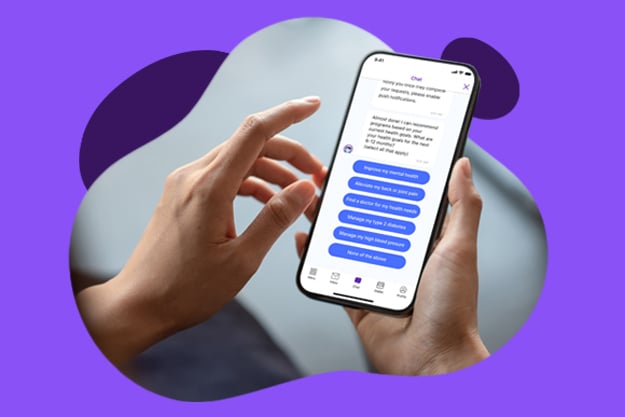How HealthJoy Gets in Front of Healthcare Decisions
For an employee, navigating the healthcare system is just a series of difficult decisions. With unclear pricing and confusing deductibles, it’s...
Connected Navigation Platform
Guiding to high-value care
Behavioral Health
Foster a mentally healthy workplace
EAP
Supporting holistic wellbeing
Virtual MSK Care
Reimagining musculoskeletal care
Virtual Primary Care
Powered by smart navigation
Surgery Centers of Excellence
Best-in-class surgical outcomes
Virtual Urgent Care
Immediate care, any hour of the day
Chronic Care
A new approach to chronic care
Integrations
Flexible to any strategy
5 min read
 Claire Wiseman Imber
:
December 8, 2021
Claire Wiseman Imber
:
December 8, 2021

Employer healthcare costs climb every year. For individuals, the stakes are perhaps even higher. Consider that as of 2021, 50% of Americans now carry medical debt, up from 46% in 2020, and that prescription drug costs increased 33% between 2014 and 2020, far more than for any other good or service.
With so much of the cost of healthcare in the hands of employees, developing a cost containment strategy is a moving target. Yet, we know it’s one of the tactics on which employers rely to drive down plan costs and improve the employee experience. No matter what strategies you and your broker are pondering, you’ve probably noticed: cost-containment ideas don’t necessarily translate to significant savings.
In this post, we’ll review most standard healthcare cost-containment techniques used by HR teams. We’ll also explore how HealthJoy’s connected healthcare navigation platform can accelerate your strategy and push you from the idea phase to one where you, and your employees, realize real savings.
Given a choice between two gas stations, can you imagine filling up at the more expensive one? We can’t, either. Employees would love to choose the most inexpensive option for their MRI, primary care visit, or annual physical. Unfortunately, medical procedure pricing isn’t as easy to compare as fuel. Even employees who want to find an inexpensive option might give up when they hit a confusing website or health plan dead-end. That can mean a higher copay for them and increased costs for your company.
Price transparency is a key ingredient to helping employees make smarter, cost-saving healthcare decisions. According to our 2021 State of the Benefits Experience Survey, nearly 60% of employers said “creating better healthcare consumers” was their top cost-containment strategy.
Our healthcare navigation platform makes it easier to achieve this goal with intuitive self-service tools and live support that emphasize transparent pricing. Say an individual member needs to find an inexpensive MRI in their city. Our healthcare concierges will research the highest quality providers, identify a fair price in their area, then send members a breakdown of the cost.
Importantly, these tools don’t rely on members to seek out transparent pricing. Instead, our year-round member communications encourage and remind employees to take advantage of provider or procedure search whenever they need to seek quality care. These communications help them understand that finding a fair-priced provider isn’t just a matter of going where their doctor recommends, but doesn’t have to be complicated, either.
Healthcare costs will never be as transparent as pricing at the corner gas station. With HealthJoy on hand, employees can easily find the care they need at the right price and learn a thing or two about price transparency along the way.
We know that encouraging employees to shop for healthcare is an excellent cost-containment strategy — but it can require employees to put in extra work. Onsite clinics let employers lower barriers to access and can allow an employee to leap the hurdle of searching for care altogether.
These all-in-one wellness centers typically offer a lower price for acute and primary care services and might also simplify access to weight-loss programs, mental health services, and condition management. They keep preventive medicine top-of-mind for employees, making it easier to stay healthy, manage their chronic illnesses more effectively, and save time.
Investing in an onsite clinic can pay off in increased productivity and lower rates of absenteeism. In Mercer’s 2021 Worksite Clinics Report, virtually all respondents (98%) rated “patient access” either a 4 or 5 in importance on a five-point scale, and nearly as many said that “quality of medical services” and “patient satisfaction” were important objectives. There was notable growth from their 2018 survey in the percentage of employers giving a high rating to productivity (91% up from 75%) and employee attraction and retention (88% up from 59%). Among those that have measured ROI, 43% of respondents reported an ROI of 1.5:1 or greater, and 31% reported an ROI of 2:1 or greater. Only 1% reported they will decrease the number of clinic locations because of the global health crisis.
HealthJoy works alongside your onsite clinic to increase participation. Our benefits wallet integrates with clinic benefits to remind users of this option every time they open the app. Year-round education from our virtual assistant JOY works even harder to keep your clinic top-of-mind. We can also send results from a HealthJoy telemedicine consultation to an onsite clinic for a seamless follow-up experience.
Telemedicine saw a resurgence during the pandemic. In our January 2021 pulse survey, 75% of employees said they never used telemedicine prior to COVID-19, but more than one-third (35%) of those same respondents report they have used it since. Overall, 59% of the employees we surveyed said at least one person in their household had used telemedicine since the start of COVID-19.
That’s great news for cost containment, because, like onsite clinics, virtual urgent care solutions allow employees to avoid expensive claims, spend fewer hours at the doctor, and sidestep unnecessary spending.
A 2015 study from the American Journal of Managed Care estimated that it takes 121 minutes, inclusive of travel time and visit time, each time someone seeks care. If you consider that Americans, on average, earn around $31 per hour in 2021, that can mean a productivity savings of $62 or more per telemedicine visit.
HealthJoy’s virtual urgent care solution can usually facilitate a screen-to-screen meeting with a medical professional for our members in less than 30 minutes.
Most basic telemedicine vendors can help clients achieve a break-even ROI, but with higher utilization, you might see savings of 10-20x more. Our live concierges redirect members to telemedicine when appropriate, and communications from our virtual assistant, JOY, ensure they’re aware of their benefit.
With higher telemedicine utilization, HealthJoy allows you to add the ease of automation to your cost containment efforts.
As our population ages and chronic illness rates increase, case-management services offer a way to bridge gaps in care. Case managers help patients with chronic or acute illnesses coordinate care and navigate their approved treatment plans, with rehabilitation in mind. Though case-management services might require an investment, they can also yield significant savings — especially when you consider that impaired performance from chronic illness costs employers an estimated $575 billion per year. Cancer, diabetes, HIV, and cardiovascular disease, conditions that are commonly addressed by case-management services, are expected to continue as leading drivers of employer healthcare costs in the years to come.
Self-funded clients can benefit from HealthJoy TPA+, an elevated HealthJoy service level that enhances proactive outreach capabilities through seamless integration with your third-party administrator (TPA). We help increase case management participation through communications from JOY and our healthcare concierge team, reminding members through the app that support is only a call away.
Untreated mental health conditions are a huge driver of healthcare costs. For one thing, employees struggling with mental and emotional stress tend to miss work. When they are present, they’re distracted and less productive. One report estimates that depression and anxiety cause a loss of $1 trillion in productivity per year. Employee Assistance Programs, or EAPs, offer cost-effective solutions to help workers proactively tackle life’s stressors. Resources are typically limited in scope, but in many cases can be just as effective as long-term or broader solutions.
A short-term counseling EAP solution, for example, might offer employees six targeted counseling sessions to help them cope after a divorce. Short-term counseling can improve presenteeism, absenteeism, and productivity markedly over a short period.
The ROI on an EAP depends on utilization. Since we know that employees often don’t use their EAPs, generating awareness and centralizing the benefits experience is essential. HealthJoy makes this process simple, with communications that keep employees engaged and educated about their benefits year-round.
Whether your goal is to improve employee health outcomes, address cost-containment, or give employees more of the benefits they want, you’ll want to consider costs. But tossing out ideas and successfully implementing a cost-containment strategy are two very different things.
Luckily, with a healthcare navigation platform on your side, cost containment can be straightforward for employees. It may even be possible to bring them along for the ride, effectively creating better healthcare consumers while also helping them live healthier, happier lives.
This post was originally published in September 2019. It was updated in December 2021.

For an employee, navigating the healthcare system is just a series of difficult decisions. With unclear pricing and confusing deductibles, it’s...

Imagine getting a credit card from your company and never seeing the bill. Now further imagine that your company allows you to use this credit...

No suite of cost containment tools enables benefits consultants to save more money for their clients than an all-in-one, benefits experience...